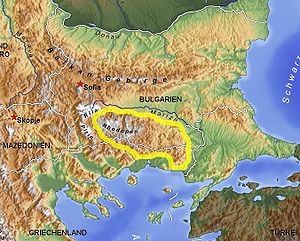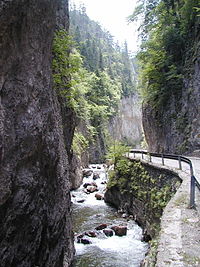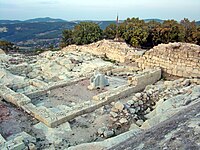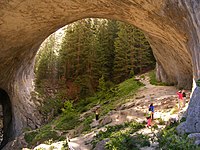Rhodope Mountains
| Rhodopes | |
|---|---|
| Bulgarian:Родопи Greek:Ροδόπη Aromanian:Rodopi Turkish:Rodoplar | |
 | |
| Highest point | |
| Peak | Golyam Perelik |
| Elevation | 2,191 m (7,188 ft) |
| Coordinates | 41°36′04″N24°34′27″E/ 41.60111°N 24.57417°E |
| Dimensions | |
| Length | 240 km (150 mi) west-east |
| Width | 100 km (62 mi) north-south |
| Area | 14,735 km2(5,689 sq mi) |
| Geography | |
| Countries | Bulgaria and Greece |
| Geology | |
| Type of rock | granite, gneiss, marble and quartz |

TheRhodopes(/ˈrɒdəpiːz/;Bulgarian:Родопи,Rodopi;Greek:Ροδόπη,Rodopi;Turkish:Rodoplar) are a mountain range inSoutheastern Europe,and the largest by area inBulgaria,with over 83% of its area in the southern part of the country and the remainder inGreece.Golyam Perelikis its highest peak at 2,191 meters (7,188 ft). The mountain range gives its name to the terrestrialecoregionRodope montane mixed foreststhat belongs in thetemperate broadleaf and mixed forestsbiomeand thePalearctic realm.The region is particularly notable for itskarstareas with their deep river gorges, large caves and specific sculptured forms, such as theTrigrad Gorge.
A significant part of Bulgaria'shydropowerresources are located in the western areas of the range. There are a number of hydro-cascades and dams used for electricity production, irrigation, and as tourist destinations. In Greece, there are also thehydroelectric power plantsof Thisavros and Platanovrysi. The Rhodopes have a rich cultural heritage including ancientThraciansites such asPerperikon,TatulandBelintash,and medieval castles, churches,monasteries,and picturesque villages with traditional Bulgarian architecture from the 18th and 19th centuries.
Name and mythology[edit]
The name of the Rhodope Mountains is ofThracian origin.Rhod-ope (Род-oпа) is interpreted as the first name of a river, meaning "rusty/reddish river", whereRhod-has the same Indo-European root as the Bulgarian "руда" (ore, "ruda" ), "ръжда" (rust, "rǎžda" ), "риж" (red-haired, "riž" ), Latin "rufus" (red), German "rot" (red), English "red", Greek ροδ- (rodh).[1][2]
InGreek mythology,Queen RhodopeofThrace,the wife of KingHaemusof Thrace, offended the gods,[3]and was changed into a mountain byZeusandHeraas a punishment along with her husband.[1]
The mountains are also associated with the mythic figure ofOrpheus.[4]
In theMiddle Ages,the mountains were known as the Slavey Mountains (Slaveyev Mountains), and under Ottoman rule were known as the Dospatsky Mountains, after theDospat MunicipalityandDospat River.[citation needed]
Geography[edit]

Ingeomorphologicalterms, the Rhodopes are part of theRila-Rhodopemassif,which is the oldest landmass on theBalkan peninsula.[5]The Rhodopes are spread over 14,735 square kilometers (5,689 sq mi), of which 12,233 square kilometers (4,723 sq mi) are on Bulgarian territory. They have the greatest extent of any single mountain range in Bulgaria. The mountains are about 240 kilometers (149 mi) long and about 100 to 120 kilometres (62 to 75 mi) wide, with an average altitude of 785 meters (2,575 ft). To the north the mountain slopes descend steeply towards theUpper Thracian Plain.To the west, the Rhodopes reach the Avram saddle, Yundola and the valley of theMesta River.To the south and east they extend to the coastal plains ofGreek Thrace.The Rhodopes are a complex system of ridges and deep river valleys.
Fifteen reserves have been established in the region, some of which are underUNESCOprotection. The mountains are famous for the largestconiferouswoods in the Balkans, their mild relief and the lush vegetation in the western parts as well as the abundance ofbirds of preyin the eastern areas.
Climate[edit]


The location of the Rhodopes in the southeastern part of theBalkan Peninsulalargely determines the climate in the region. It is influenced both by the colder air coming from the north and by the warmer breeze from theMediterranean.
The average annual temperature in the Eastern Rhodopes is 13 °C (55 °F), the maximum precipitation is in December, the minimum in August. In the Western Rhodopes, the temperature varies from 5 to 9 °C (41 to 48 °F) and in the summer rainfalls prevail.
The mild climate, combined with some other factors, works in favour of the development of recreation and tourist activities. ThePamporovoresort, where the microclimate permits a heavy snow cover to be preserved for a long time, is an excellent example.
Temperatures as low as −15 °C (5 °F) are common in winter, and due to this the Rhodopes are the southernmost place in the Balkans where tree species such as theNorway Spruceand theSilver Birchcan be found.
Waters[edit]

The mountains have abundant water reserves, with a dense network of mountain springs and rivers. Nearly 80% of the mountain's territory falls within the drainage of the riverMaritsa.The natural lakes are few, the most renown of these being theSmolyan lakessituated at several kilometers from the town of the same name. Some of the largest dams in the country are located in the Rhodopes including theDospat Dam,Batak Dam,Golyam Beglik,Kardzhali Dam,Studen Kladenets,Vacha Dam,Shiroka Polyanaand many others, while in Greece there are the dams of Thisavros and Platanovrysi. They are used mainly forhydro-electric powergeneration and for irrigation. There are many mineral water springs, the most famous being inVelingrad,Narechen,Devin,Beden,Mihalkovoand others. In Greece there are mineral water springs in Thermes, 40 km. north of (Xanthi) and in Thermia, 60 km. north ofDrama,at 620 m.
Subdivision[edit]
Western Rhodopes[edit]


The Western Rhodopes are the largest (66% of the area of the Rhodopes in Bulgaria), higher, most infrastructurally developed, and most visited part of the mountains. The highest and best known peaks are located in the region (more than 10 are over 2,000 meters (6,562 ft) high) including the highest one,Golyam Perelik(2,191 meters (7,188 ft)). Among the other popular peaks areShirokolashki Snezhnik(2,188 meters (7,178 ft)),Golyam Persenk(2,091 meters (6,860 ft)),Batashki Snezhnik(2,082 meters (6,831 ft)),Turla(1,800 meters (5,906 ft)).
Some of the deepest river gorges in the Rhodopes are located in the western parts, as well as the rock phenomenonWonderful Bridges.Significant bodies of water include the Chaira lakes and theDospat,Batak,Shiroka Polyana,Golyam BeglikandTsigov Charkdams.
The town ofBatakis also located in this part of the mountains, as well as the popular tourist centresSmolyan,Velingrad,Devin,Chepelare,the winter resortPamporovo,theEastern OrthodoxBachkovo Monastery,the ruins of theAsen dynasty's fortress, and the Devil's Throat, Yagodinska, and Uhlovitsa caves. The highest village in Bulgaria, Manastir (over 1,500 meters (4,921 ft)), is crouched in the northern foot of Prespa Peak. A number of architectural reserves, such as Shiroka Laka, Kovachevitsa, Momchilovtsi,Kosovo,are also located in the area.
Eastern Rhodopes[edit]
The Eastern Rhodopes are spread over a territory of about 34% of the mountains' area in Bulgaria, constituting a much lower part.
The large artificial damsKardzhaliandStuden Kladenetsare located in this part of the mountains. The region is rich in thermal mineral springs. The waters aroundDzhebelhave national reputation for healing various diseases.Belite Breziis an important healing centre for respiratory and other ailments.
Major cities in the area areHaskovoandKardzhali,as well as the smallerMomchilgrad,Krumovgrad,ZlatogradandKirkovo.The Eastern Rhodopes, being significantly lower, are also more populated than the western part.
Almost every species of theEuropeanbirds of preynest in the rocks and forests of the Eastern Rhodopes including the rareblack vultureandEgyptian vulture.
Southern (Greek) Rhodopes[edit]


The Southern Rhodopes are the part of the mountain range that is located in Greece. TheRhodope regional unitin the northern part of the country is named after the region. This area includes the Rodopi Mountain Range National Park.[6]

The Southern Rhodopes are characterized by numerous peaks of relatively low altitude. Their highest peak is Delimposka (1,953m) in the mountain of Frakto, near the Greek-Bulgarian border. Nowadays the Southern Rhodopes is an area almost deserted. AfterWorld War IIand theGreek Civil Warmost villages depopulated permanently and their inhabitants never returned. Even theSarakatsanistockbreeders abandoned the difficult life of the Rhodopes. The depopulation of the region, that has not been grazed for more than 50 years, combined with high rainfall and its geographical location, has contributed to the creation and maintenance of a biological paradise. There grow coniferous trees, such as theNorway Spruceand theSilver Birch,that cannot be found elsewhere in Greece.
In the forest of Frakto there are 300-year-old trees, more than 50 metres high, and the endangeredwild goat.
In the eastern part of the region there is the well known nature reserve ofDadia Forest,an ideal habitat forbirds of prey,with 36 of the 38 species of birds of prey of Europe, like the rareEastern imperial eagleandLesser spotted eagle.
History[edit]
This sectionneeds additional citations forverification.(December 2016) |

The Rhodopes have been inhabited since thePrehistoricage. There have been manyarchaeologicalfinds of ancient tools in some of the caves.
The first known human inhabitants in the mountains were theThracians.[7]They built many temples, cities and fortresses. The most famous town in the area is the sacred city ofPerperikonlocated 15 km northeast ofKardzhali.One of the most important Thracian temples wasTatulnear the village of the same name. Additionally, there are archeological sites throughout the region related to the cult ofDionysus,such as the ancient Thracian city ofPerperikon.


The frequent mention of the Rhodope in Ancient Greek and Latin sources indicates that the mountain had played an important role in the political and religious life of the Thracian tribes that lived on it. On the tops of the mountain there was a famous oracle, which they had visited to consultAlexander the Greatand later the father ofOctavian Augustus.On the mountain were also sanctuaries of various other deities, as wasApollo,Zeus,the Thracian Horseman,Mithras,etc. Finally, Rhodope served as a true bastion of freedom of the Thracians and last refuge of resistance against the Romans. This explains the fact that Thrace became a Roman province about 200 years after Macedonia.[8]
In 2005, German scholars from the University of Heidelberg confirmed that the two rather small fragments discovered by archaeologistNikolay Ovcharovin the Eastern Rhodopes mountains are written in the MinoanLinear Ascript from about 15th century BC.[9]
In theMiddle Agesthe mountain was part of the Bulgarian andByzantine Empiresand often changed hands between the two countries. There was a dense network of castles which guarded the trade routes and the strategic heights. The largest and most important castles includeLyutitsa,Ustra,Tsepina,Mezek,Asenova krepostand many others. Between 1371 and 1375 the Rhodopes fell underOttomanoccupation in the course of theBulgarian–Ottoman wars.[10]
During the 16th and 17th centuries the Ottoman authorities began a process of Islamisation of the region.
The towns and the villages in the Western Rhodopes took active part in theApril Uprisingin 1876. When the uprising was crushed the Ottomans slaughtered around 5,000 peoplein Batak alone.[11][12][better source needed][needs update]Thousands more perished in Bratsigovo, Perushtitsa and other rebel villages which were also burnt and looted by the Ottomans.
The northern Rhodopes were ceded in 1878 to an autonomous province ofEastern Rumeliauntil its unification with thePrincipality of Bulgaria.The other part of the Rhodopes was annexed as a result of theFirst Balkan War(1912–1913) but after theSecond Balkan War(1913) and theFirst World War(1914–1918) the southern slopes of the mountain was occupied by Greece and the Bulgarian population of the area was forced to flee to Bulgaria.
People[edit]

The sparsely populated area of the Rhodopes has been a place of ethnic and religious diversity for hundreds of years. Apart from theEastern OrthodoxBulgariansandGreeks,the mountains are also home to a number ofMuslimcommunities, including thePomaks,that predominate in the western parts and a large concentration ofBulgarian Turks[13]andGreek Turks,particularly in the Eastern Rhodopes. The mountains are also one of the regions associated with theSarakatsani,a nomadic Greek people who traditionally roamed betweenNorthern Thraceand theAegean coast.[citation needed]Aromanians,aRomance-speaking ethnic group, also live in the Rhodopes.[14]and Agupti who are a blend of Turks, Roma and Pomaks and don’t associate themselves with other Roma groups.[15]
Economy[edit]

The economy of the Rhodopes region is dominated by services, tourism, industry and agriculture.
Livestock breeding, forestry and tobacco are the most important agricultural activities. Due to the large Muslim population the number of pigs is relatively low but there are many sheep which are traditional for the Rhodopes. Tobacco is grown in the Eastern Rhodopes and forms a large part of the total national production.
The industrial sector is well-developed. One of the largest industries in the area is mining. There are around 80 mines forleadandzincwhose reserves are among the largest in Europe. They are situated mainly in central parts of the mountain and along the border with Greece as well as to the east.Kardzhali Provinceis rich in non-metalliferous minerals andgold.There are also small reserves ofchromiteandironore as well as significant impurities of rare metals in the lead and zinc ores. There are several flotation factories which enrich the ores before it is sent to the large lead and zinc refineries inKardzhaliandPlovdiv.The machine-building industry is developed in Smolyan, Kardzhali, Devin, Bratsigovo, Ivailovgrad and others; there is a pharmaceutical plant in Pestera. Some of the centers oftextileindustry include Zlatograd, Smolyan, Madan, Laki. The timber industry is developed mainly in the western parts where there are some of the most important forest massifs in the Balkan Peninsula. The Rhodopes are one of the main hydro-power generation regions of Bulgaria with a number of major hydroelectric power plants such as Batak, Peshtera, Aleko, Studen Kladenets, Kardzhali, Vacha and Thisavros and Platanovrysi in Greece.

Tourismis an important industry with growing significance. Pamporovo and Chepelare are major winter resorts. There are many resorts, camp sites and refuges on the shores of the dams or in the green valleys, which can be visited in the summer. The caves along the Greek border such asYagodinska,Uhlovitsa,Devil's Throat Cave,Snezhanka(near Peshtera) and others are popular among speleologists with their spectacular forms and underground lakes and rivers. The ruins of castles, Thracian sites such asPerperikonandTatul,the villages in National Revival style and the monasteries are also visited by many Bulgarian and foreign tourists.
Honour[edit]
Rodopi PeakonLivingston Islandin theSouth Shetland Islands,Antarcticais named after the Rhodope Mountains.[citation needed]
See also[edit]
- Geography of Bulgaria
- List of mountains in Bulgaria
- List of mountains of the Balkans
- List of mountain ranges
- Mantaritza Biosphere Reserve
- Rila
- Pirin
- Balkan Mountains
- Vitosha
References[edit]
- ^abDechev, Dimitar (1925). "Хемус и Родопи [Hemus and Rhodope]".Годишник на Софийския университет, Историко-филологически факултет[Yearbook of Sofia University, Faculty of History and Philology] (in Bulgarian). Vol. XXI.10. Sofia: Faculty of History and Philology,Sofia University.p. 31.
- ^Duridanov, Ivan (1985).Die Sprache der Thraker.Bulgarische Sammlung (in German). Vol. 5. Hieronymus Verlag. p. 41.ISBN3-88893-031-6.
- ^Rhodope offended the gods and was turned into a mountain in Thrace [Ov.Met.6.83].
- ^Norman, Philip (21 September 2012)."Bulgaria: Between heaven and hell".The Independent.Retrieved23 October2020.
- ^The Rilo-Rhodope massif is sometimes referred to as the Rhodope mountains alone.
- ^"Rodopi Mountain Range National Park".www.fdor.gr.
- ^Iliev, J. Rhodope Mountain in Thrace according to concepts of the ancient writers. – Rhodopica, 2007, 1, p. 89 ff.
- ^D. C. Samsaris, Historical Geography of Western Thrace during the Roman Antiquity (in Greek), Thessaloniki 2005, pp. 15–33
- ^Linear A script from the Eastern Rhodopes? (May 2005)
- ^Иречек, К. История на българите, С., 1929, с. 248
- ^Sir Edwin Pears, Forty Years in Constantinople, London, 1915, chapter II.
- ^Turks in Bulgarian – Gladstone's article – Bulgarian Horrors and the Question of the East, London, 1876
- ^"Bulgarian Turks: In the Middle".
- ^Constantin, Marin (2014)."The ethno-cultural belongingness of Aromanians, Vlachs, Catholics, and Lipovans/Old Believers in Romania and Bulgaria (1990–2012)"(PDF).Revista Română de Sociologie.25(3–4): 255–285.
- ^Marušiakova, Elena; Popov, Veselin (2000)."The Bulgarian Gypsies – Searching their Place in the Society".Balkanologie.4(2).doi:10.4000/balkanologie.323.
- Asdracha, Catherine,La région des Rhodopes aux XIIIe et XIVe siècles:étude de géographie historique, Athen: Verlag derByzantinisch-Neugriechischen Jahrbücher,1976, p. 294.
- Evangelos A. Papathanassiou. "The Armenian Presence in and around the Rhodope Mountain in 11th C.: Rethinking over some new archaeological Finds", Περὶ Θράκης 7 (2010–2015), 59–97.In: auth.academia.edu/EvangelosPapathanassiou
External links[edit]
- Rhodope Mountains
- Mountain ranges of Bulgaria
- Mountain ranges of Greece
- Geography of Europe
- International mountains of Europe
- Bulgaria–Greece border
- Landforms of Smolyan Province
- Landforms of Pazardzhik Province
- Landforms of Kardzhali Province
- Landforms of Haskovo Province
- Landforms of Blagoevgrad Province
- Landforms of Rhodope (regional unit)
- Landforms of Xanthi (regional unit)
